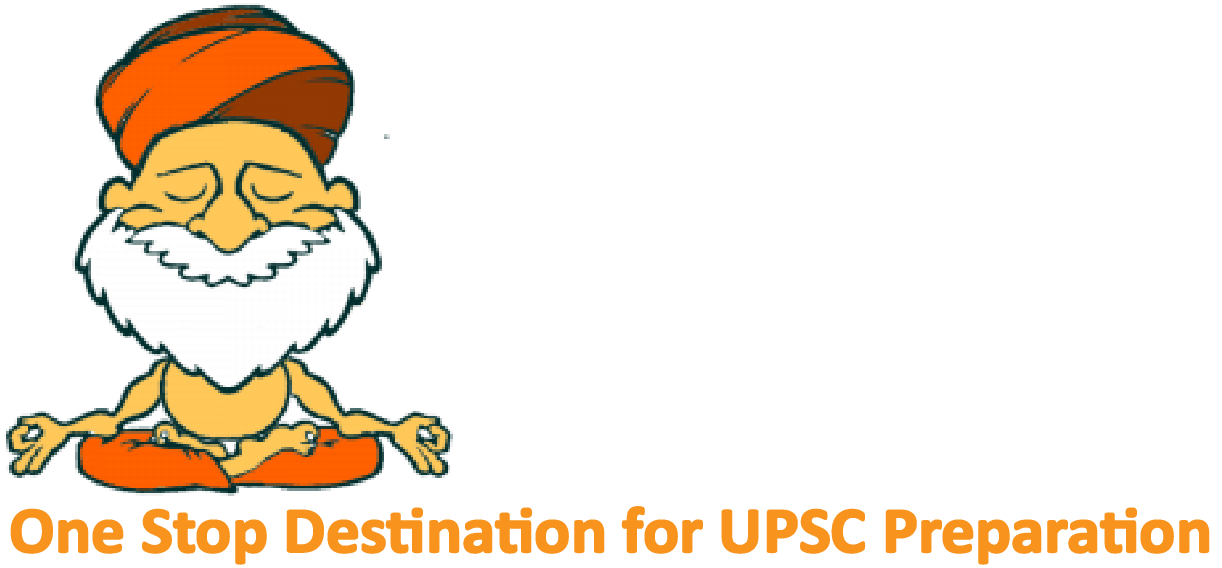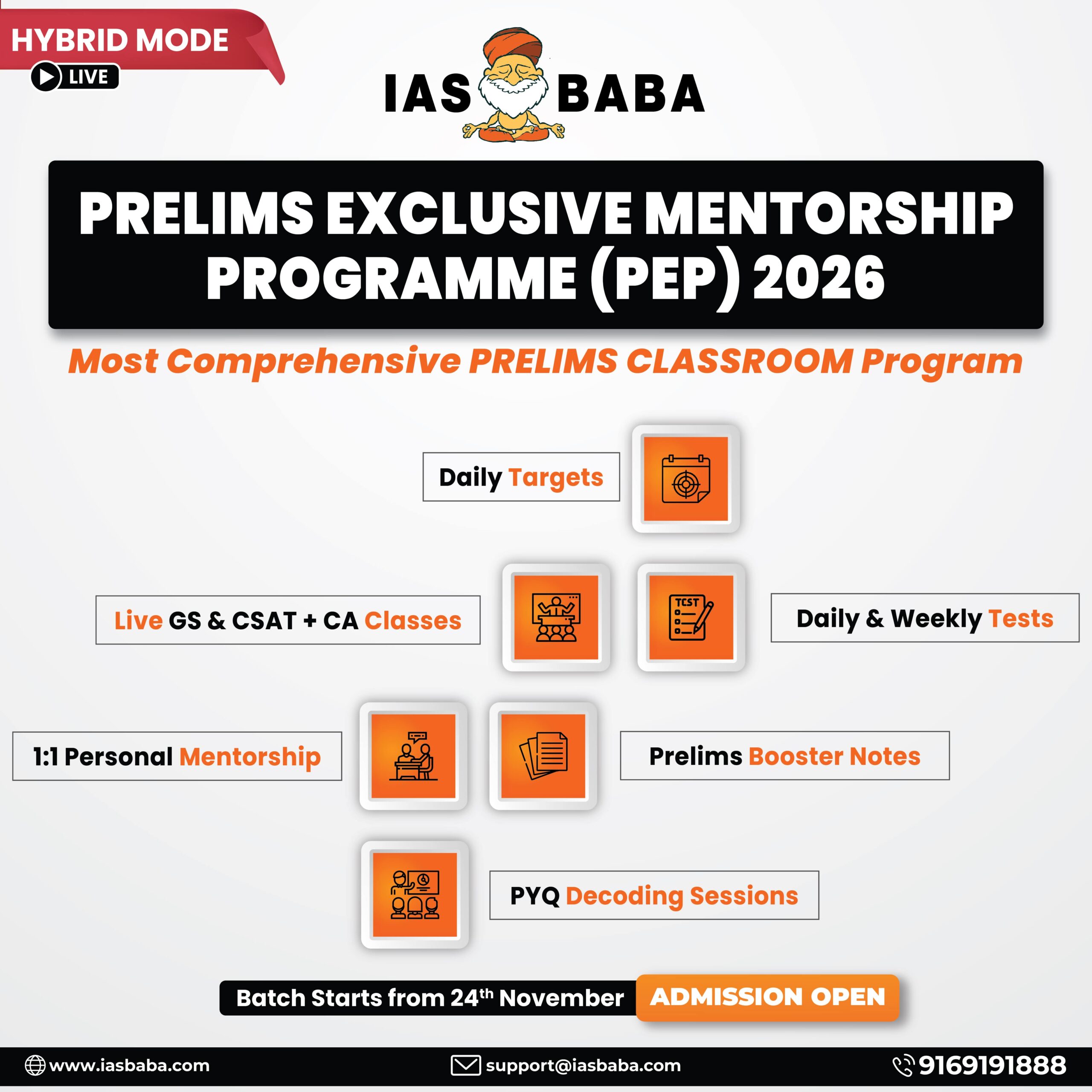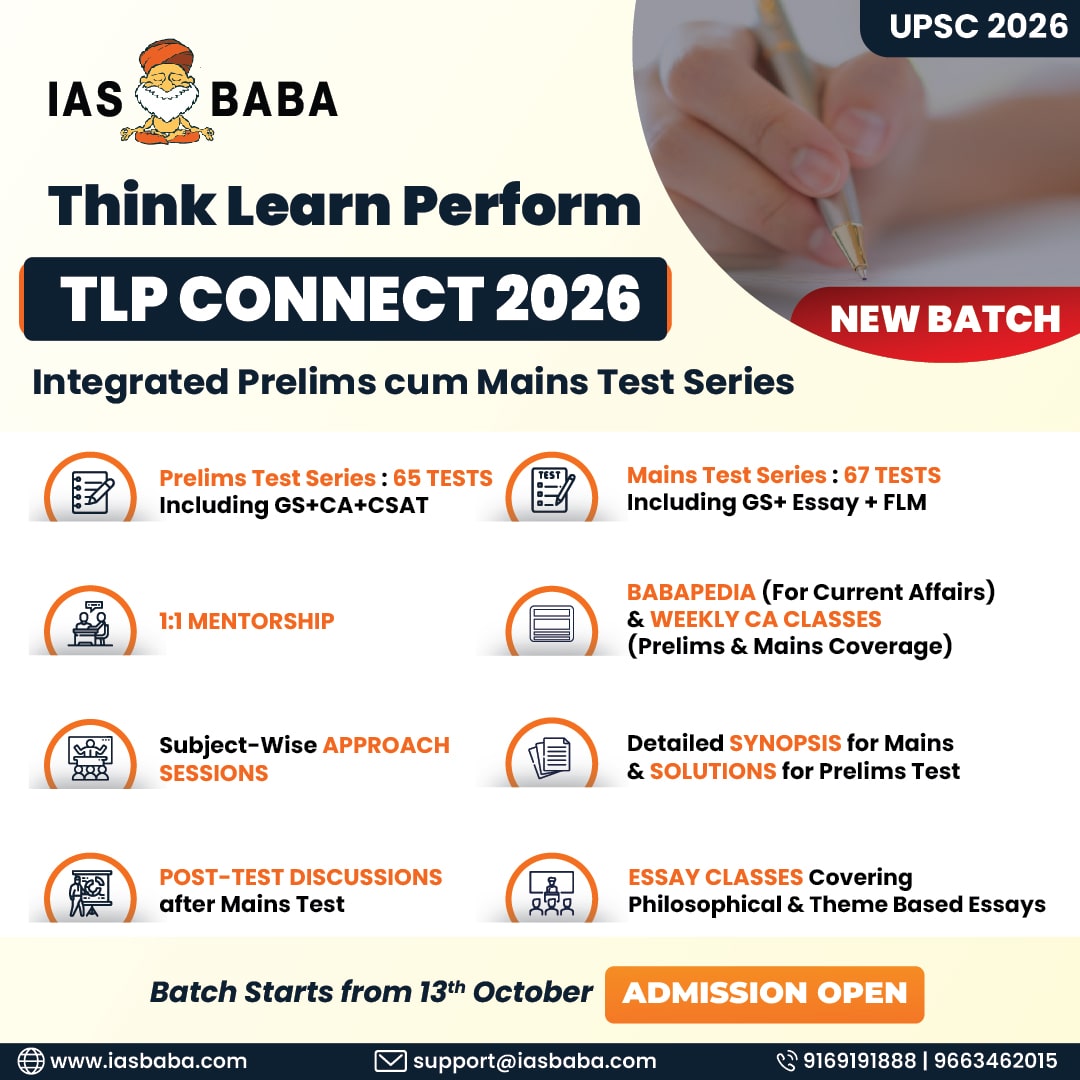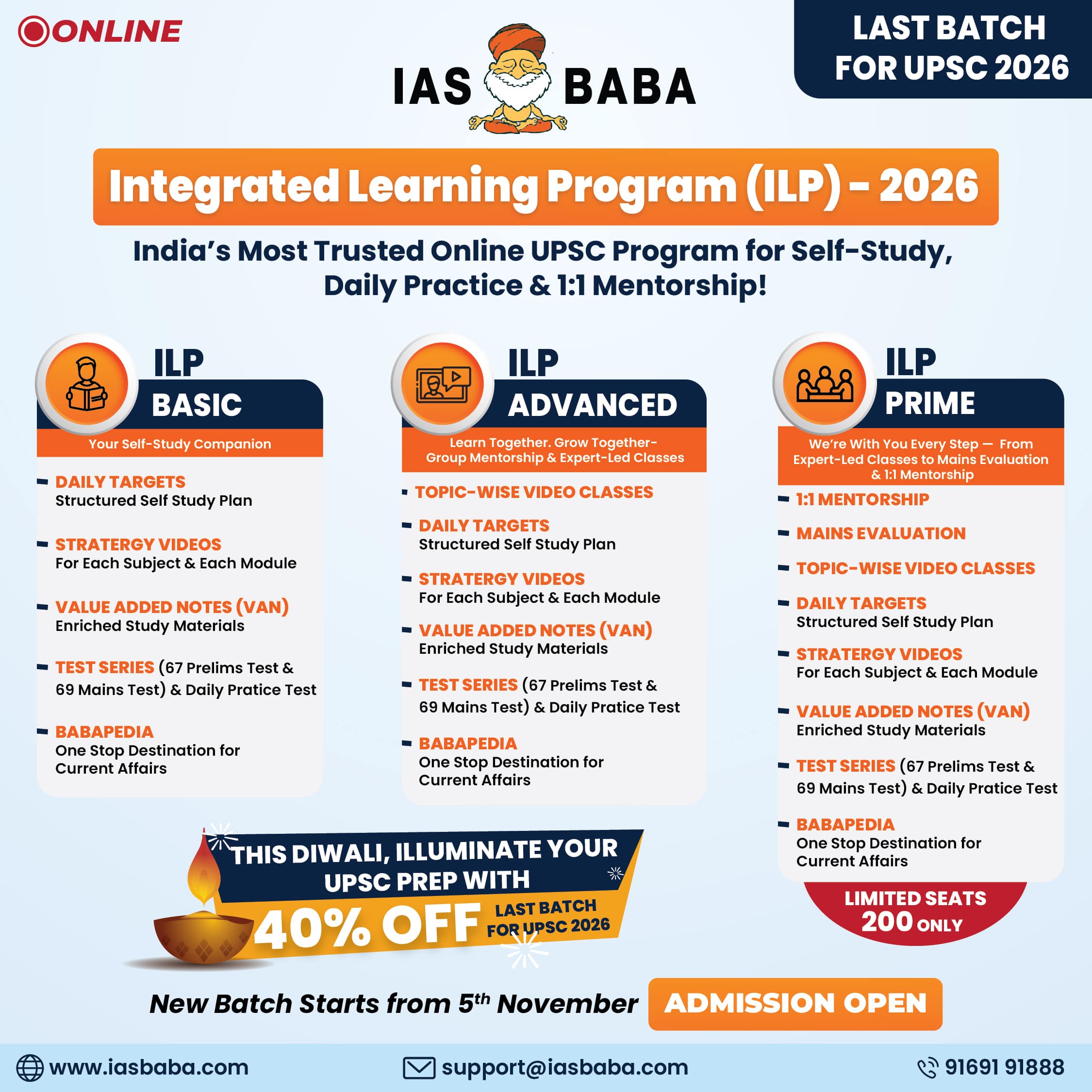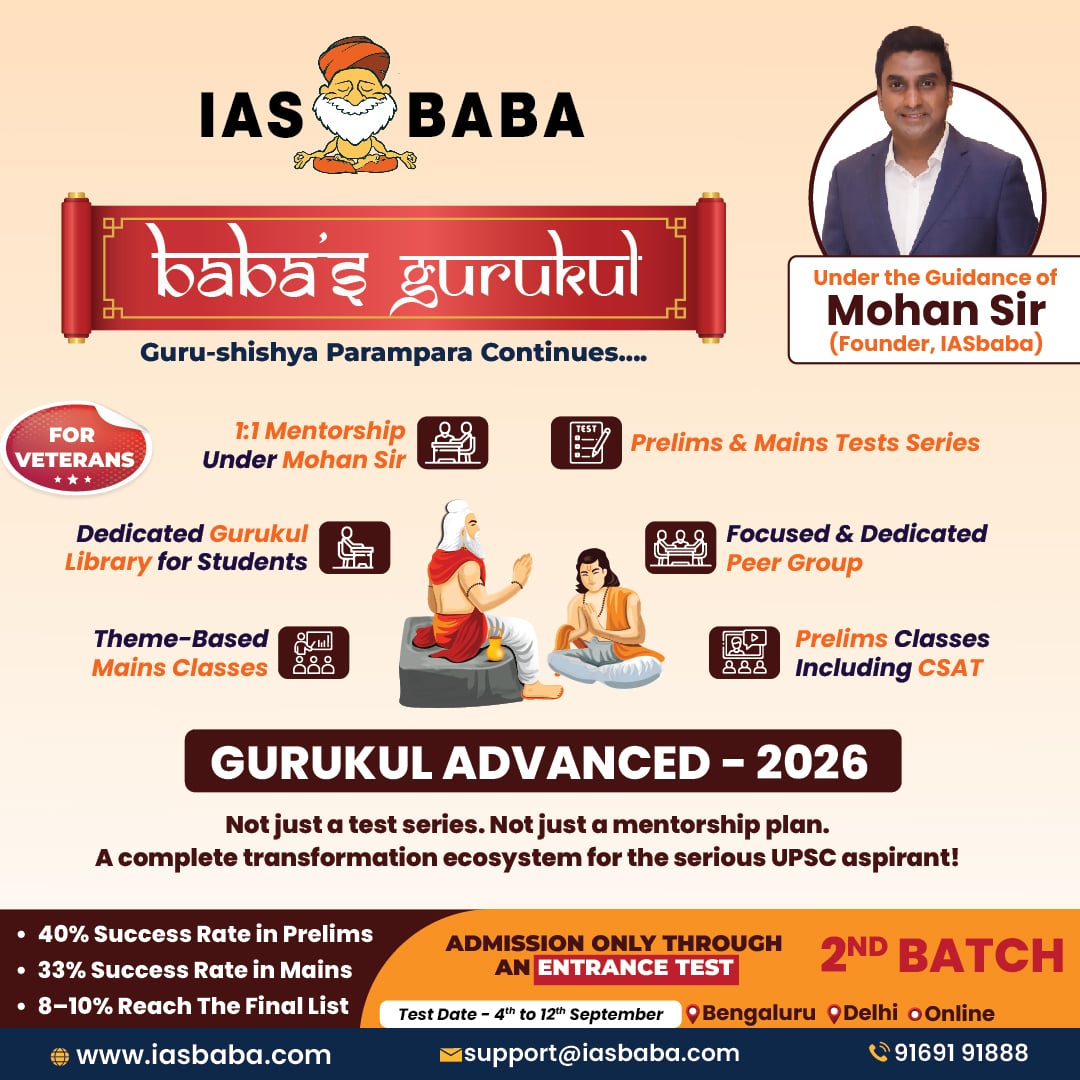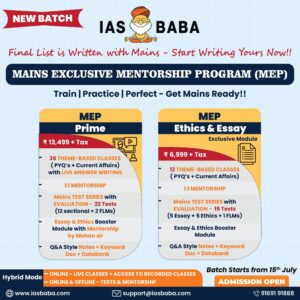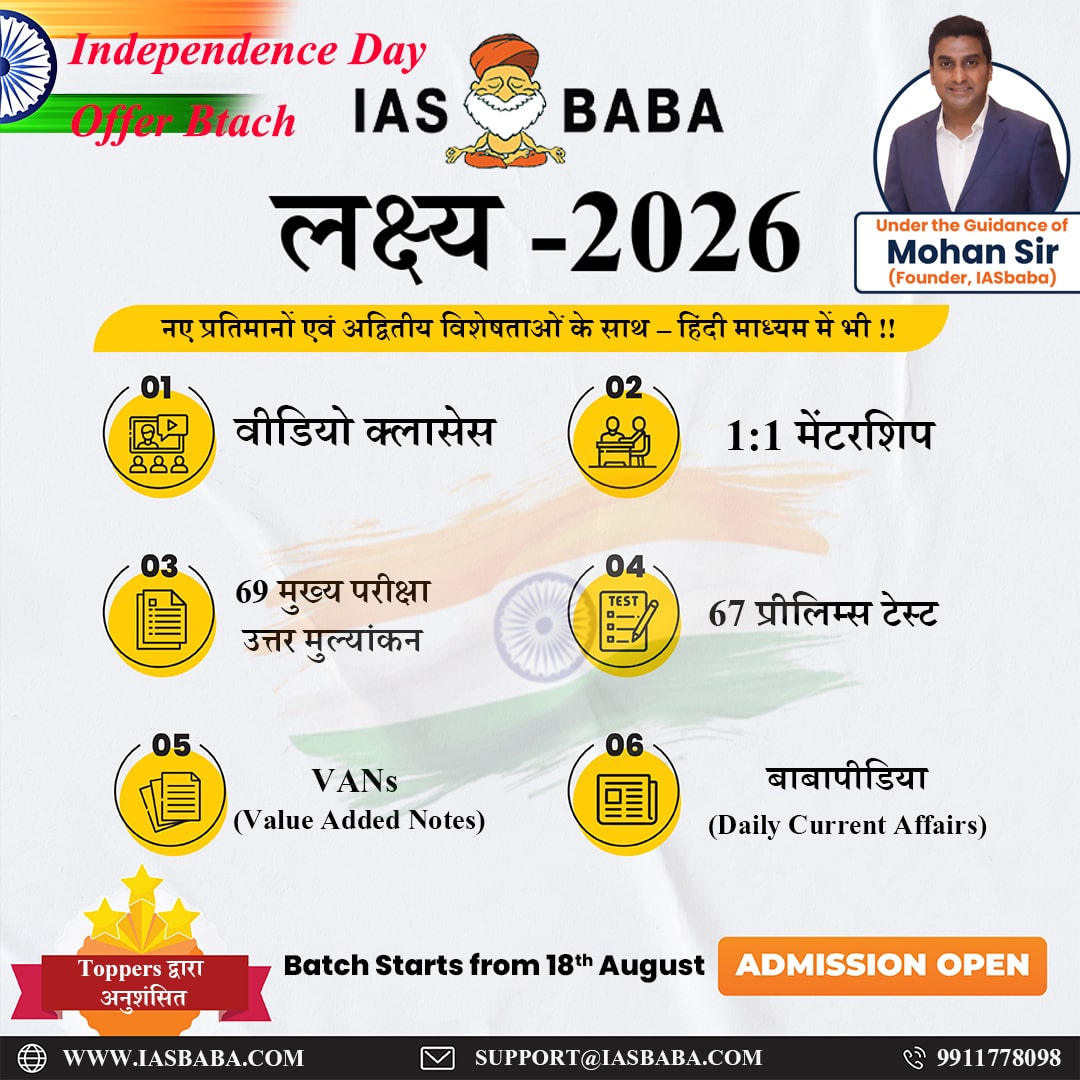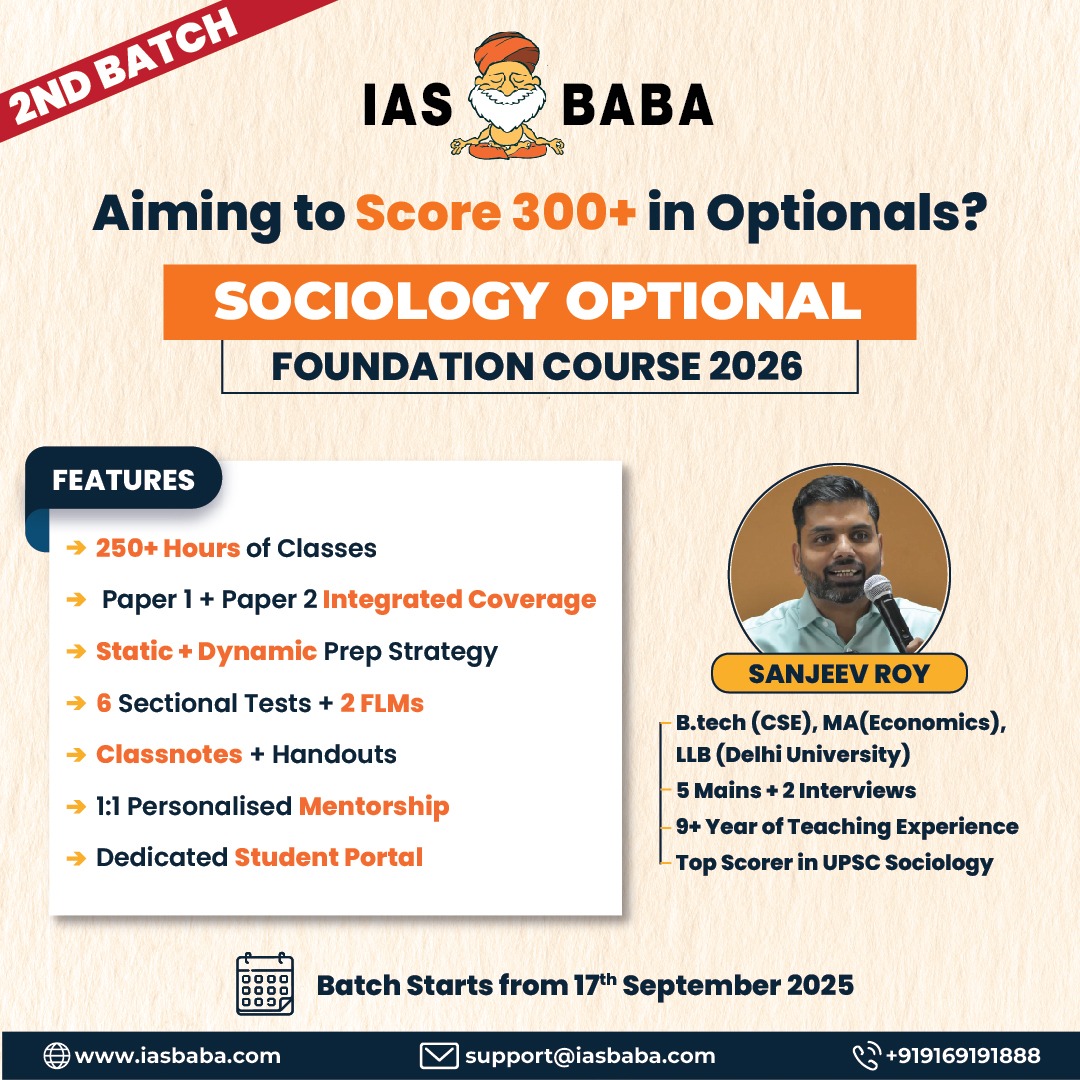IASbaba's Daily Current Affairs Analysis
Archives
(PRELIMS & MAINS Focus)
Syllabus:
- Prelims & Mains – ECONOMY
Context: Finance Minister Nirmala Sitharaman presented her eighth consecutive Budget on Feb 1st.
Background: –
- Finance Minister lists four engines of development in the Union Budget 2025-26. These are agriculture, MSMEs, investments, and exports.
Key takeaways
Agriculture
- The government will promote self-sufficiency in pulses, focusing on the production and procurement of toor, urad, and masur.
- Bihar will get a Makhana board, to boost the cultivation and marketing of fox nuts. The people engaged in Makhana cultivation will be organized in FPOs. Bihar accounts for about 85 per cent of the total Makhana production of the country.
- ‘Rural Prosperity and Resilience’ program will be launched in collaboration with states. This initiative aims to tackle under-employment in agriculture by promoting skill development, investment, technology adoption, and revitalization of the rural economy. The objective is to create abundant opportunities in rural areas, ensuring migration remains a choice rather than a necessity.
- A National Mission on High Yielding Seeds will be launched.
- The loan limit under the Modified Interest Subvention Scheme will be enhanced from Rs. 3 lakh to 5 lakh for loans taken through the KCC.
- A new scheme for the agriculture sector—Prime Minister Dhan Dhanya Krishi Yojana (PMDDKY). The scheme will be on the lines of Aspirational Districts Programme (ADP) and will be implemented across agriculture districts.
MSMEs
- To help them achieve higher efficiencies of scale, technological upgradation and better access to capital, the investment and turnover limits for classification of all MSMEs will be enhanced.
- In a boost to credit to Micro industries, the government will provide customised credit cards with limit of Rs 5 lakh under Udyam portal.
- Building on the National Action Plan for Toys, the government will implement a scheme to make India a global hub for toys – promoting ‘Make in India’ brand.
- The government will launch the National Manufacturing Mission covering small, medium, and large enterprises for furthering Make in India. The Mission will also support clean tech manufacturing, given India’s commitment to climate-friendly development.
Investments
- Extension of Jal Jeevan Mission until 2028 to obtain 100 percent coverage.
- The Government will establish a ₹1 lakh crore Urban Challenge Fund to support initiatives like ‘Cities as Growth Hubs,’ ‘Creative Redevelopment,’ and ‘Water & Sanitation’. The fund will cover up to 25% of viable project costs, requiring at least 50% funding from bonds, bank loans, or PPPs.
- A Nuclear Energy Mission for research & development of Small Modular Reactors (SMR) with an outlay of Rs. 20,000 crore will be set up.
- The Shipbuilding Financial Assistance Policy will be revised to offset cost disadvantages, including Credit Notes for shipbreaking in Indian yards to support the circular economy.
- Budget announced a ‘Deep Tech Fund of Funds’ for next generation startups and ten thousand PM research fellowships for technological research in IITs and IISc in next 5 years.
- The 2nd Gene Bank was announced with 10 lakh germplasm lines will be set up for future food and nutritional security. (Supporting both public and private sector.)
Exports
- Establish an Export Promotion Mission to enhance export credit access and support MSMEs in global markets.
- BharatTradeNet: Develop a unified digital platform for international trade documentation and financing solutions.
- Global Supply Chain Integration: Support domestic manufacturing to integrate India’s economy into global supply chains, focusing on Industry 4.0 and youth talent.
- National Framework for GCC: Create a framework to promote Global Capability Centres in tier 2 cities, focusing on talent and infrastructure.
Source: Indian Express
Syllabus:
- Prelims & Mains – POLITY
Context: In the gale of executive orders announced after Trump assumed office for a second term, the President issued one diluting birthright citizenship, which has been written into the U.S. Constitution since 1866. The order has been challenged in court in more than 20 States and a federal judge has temporarily blocked it.
Background: –
- If implemented, it will mean that children born to illegal immigrants — as well as those legally in the U.S. on temporary visas for study, work or tourism purposes — will not be eligible for automatic U.S. citizenship. At least one parent must now be a U.S. citizen or legal permanent resident, the order says.
Key takeaways
- The 14th amendment to the U.S. Constitution, which granted citizenship to “all persons born or naturalized in the United States, and subject to the jurisdiction thereof” was enacted in 1866, against the backdrop of the Civil War which had just ended.
- Trump’s supporters rail against the practice of birth tourism, or anchor babies, where foreign nationals seek to give birth in the U.S., in the hope that those babies will be able to help their families migrate to the country as well.
How do citizenship laws vary?
- The U.S. follows the principle of jus soli (the right of soil), based on geography regardless of parental citizenship, as opposed to jus sanguinis (the right of blood), which gives citizenship based on the nationality of the child’s parents.
- There are only 37 countries which currently enforce the jus soli principle, of which 29 are in the Americas. Of the other eight, two are in India’s neighbourhood: Nepal and Pakistan, though the latter introduced a Bill seeking to end this.
- Jus soli historically allowed colonisers to quickly outnumber native populations as citizens. Countries that have traditionally built their national character through diverse immigrant populations have used jus soli as a way of integrating diversity into the common stream of nationhood.
- Countries protective of their culture and identity have generally followed the principle of jus sanguinis.
- Jus soli derives from English common law and, until anti-migrant backlash a few decades ago, was implemented in the U.K. and most of its former colonies, including India.
- India offered automatic citizenship to all those born on Indian soil before 1987. Introducing the Citizenship Bill in Parliament in 1955, then-Home Minister Govind Ballabh Pant said, “The mere fact of birth in India invests with it the right of citizenship in India. We have taken a cosmopolitan view and it is in accordance with the spirit of the times, with the temper and atmosphere which we wish to promote in the civilised world.”
- Three decades later, sentiments changed, in the wake of unrest in Assam due to migration from Bangladesh as well as the refugees from Sri Lanka, following the civil war there. “The time has come to tighten up our citizenship laws. We cannot be generous at the cost of our own people, at the cost of our own development,” said P. Chidambaram, Union Minister of State for Home Affairs, while introducing the Citizenship (Amendment) Bill in the Lok Sabha in 1986.
Source: The Hindu
Syllabus:
- Prelims – ENVIRONMENT
Context: The 32.78 hectare area of Guneri village in Lakhtar tehsil of Kutch district, which is a natural inland mangrove site, has been declared as the first Biodiversity Heritage Site (BHS) of Gujarat.
Background:
- The announcement has been done under the provisions of The Biodiversity Act, 2002. The Act empowers the state government to notify an area as a BHS after consulting concerned local bodies.
Key takeaways
- Inland mangroves are rare and have been reported from only eight locations across the globe till date. The Guneri inland mangrove site is the last remains of its kind in India.
- Mangroves are typically sighted at the sea coast which is sludgy and accessed by seawater at least once every day. However, the Guneri mangrove site is located at a distance of 45 km from the Arabian Sea and four km from the Kori Creek, where seawater never approaches. It is also devoid of any sludge, and is spread over a flat piece of land like a forest.
- The Guneri inland mangroves are presumed to have originated either after the marine transgression which occurred in the area during the Miocene period or on the bank of the lost river (the Saraswati River) in the Great Rann of Kachchh. The Saraswati, a mythological river, is assumed to have once run in the Great Rann of Kachchh during 3000-4000 B.C.
- Studies have reported that the inland mangroves survive in areas having limestone deposition which connects with the sea bed. The limestone provides a continuous flow of groundwater to the mangrove ecosystem/vegetation.
- The Western Kutch and areas surrounding the Guneri mangroves have records of limestone depositions.
Source: Indian Express
Syllabus:
- Prelims & Mains – CURRENT EVENT
Context: Finance Minister has announced the launch of a six-year ‘Mission for Aatmanirbharta (self-reliance) in Pulses’ with a special focus on tur/arhar (pigeonpea), urad (black gram) and masoor (red lentil). Budget has allocated Rs 1,000 crore towards this scheme, which aims to provide minimum support price (MSP)-based procurement and post-harvest warehousing solutions in respect of the three pulses crops.
Background: –
- India’s pulses imports during April-November 2024 were valued at $3.28 billion, 56.6% higher than the $2.09 billion for the corresponding period of 2023.
Key takeaways
- Domestic pulses production, as per the Agriculture Ministry’s data, increased from 192.55 lt (lakh tonnes) in 2013-14 to 273.02 lt in 2021-22 and 260.58 lt in 2022-23.
- This was mainly courtesy two crops: chana and moong (green gram). That, in turn, was enabled by the development of short-duration varieties.
- Traditional chana varieties take 140-150 days to grow from seed to grain, while requiring 1-2 irrigations. The newer varieties can be harvested in 100-120 days, with farmers having to give a single irrigation. They can sow from end-September to mid-October, after harvesting of the kharif (post-monsoon) crop and using the residual moisture left by it in the soil.
- The breeding breakthroughs is greater in moong, where farmers today take as many as four crops. The first one is during kharif, second is during rabi (winter), third is grown in spring (February-March sowing) and the last one over summer (after April 1-20 sowing). The summer and rabi moong crops mature in 50-60 days, while it is slightly longer (65-75 days) for the kharif and spring varieties.
- In moong, Indian scientists have bred varieties that are not just short-duration, but also photo-thermo insensitive: Being non-sensitive to temperature or photoperiod (the length of time in a 24-hour period that plants are exposed to light), they can practically be grown anytime and anywhere.
- Breeding apart, the government has made some concerted effort at MSP procurement of both chana and moong. The Modi government probably wants to replicate the above success story and extend it to other pulses – namely tur/arhar, urad and masoor.
The challenge
- There are growing limitations, particularly in tur/arhar, which was traditionally a 250-270 days crop yielding around 20 quintals/hectare. Breeders brought the duration down to 150-180 days with 15-16 quintals/hectare yields, but that’s still long and low. As a result, tur/arhar is confined largely to the rainfed Marathwada-Vidarbha regions of Maharashtra and northern Karnataka, where farmers have fewer alternative cropping options.
- Aatmanirbharta in tur/arhar would, perhaps, require development of hybrids maturing within 140-150 days, giving 18-20 quintals/hectare yields and also amenable to mechanical harvesting.
- The second factor has to do with policy ambiguity. The Modi government wants farmers to expand pulses acreages and plant these nitrogen-fixing leguminous crops, instead of the more water-guzzling cereals or sugarcane. But tur/arhar is now wholesaling at prices lesser than its MSP.
- Moreover, the Centre, on January 20, allowed duty-free imports of tur/arhar for an additional year up to March 31, 2026. Imports of most other pulses – matar, masoor, urad and desi (small-sized) chana – are also attracting zero duty.
Source: Indian Express
Syllabus:
- Prelims – SCIENCE & TECHNOLOGY
Context: The US Food and Drug Administration approved a new type of non-opioid painkiller. Although expensive, the medicine is not addictive, unlike commonly used opioid painkillers. The drug, suzetrigine, will be sold under the brand name Journavx, and manufactured by US-based Vertex Pharmaceuticals.
Background: –
- The number of opioid overdoses has increased in recent years in several countries, in part due to the increased availability of opioids used in the management of chronic pain, and also due to increasing use of highly potent opioids appearing on the illicit drug market.
Key takeaways
What are opioids?
- Opioids are a class of drugs that “derive from, or mimic, natural substances found in the opium poppy plant”. Some common opioids include oxycodone, morphine, codeine, heroin, and fentanyl.
- Prescription opioids are primarily used for pain relief. They do so by getting attached to opioid receptors in the brain cells to release signals that block the perception of pain, and boost the feelings of pleasure or euphoria.
- Although opioids have several benefits and are extremely effective as painkillers, they can be quite addictive.
How does suzetrigine work?
- Pain is essentially a signal from one’s body to the brain that something potentially harmful has happened or is happening to the body. It is meant to prompt a reaction where one avoids further damage.
- Several body parts are involved in the sensation of pain. First are specialised nerve endings or ‘nocireceptors’ which are widely distributed across the body. Any tissue damage activates these receptors which send electrical signals through the spinal cord to the brain, which then interprets these as pain.
- Unlike opioids, which numb the sensation of pain in the brain, suzetrigine works by targeting pain signals before they reach the brain. Since suzetrigine does not produce any sensation of pleasure or euphoria, experts believe that the drug could not create addiction or dependence.
Source: Indian Express
Practice MCQs
Q1.) With reference to Citizenship Laws, consider the following statements:
- Jus soli refers to the right to citizenship based on birthplace, whereas jus sanguinis grants citizenship based on the nationality of one’s parents.
- Countries emphasizing cultural identity tend to follow jus sanguinis.
- India granted automatic citizenship to all those born on Indian soil before 1987.
Which of the above statements is/are correct?
(a) 1 and 3 only
(b) 2 and 3 only
(c) 1 and 2 only
(d) 1, 2, and 3
Q2.) Consider the following statements regarding Guneri Inland Mangroves:
- They are the first Biodiversity Heritage Site (BHS) of Gujarat.
- These mangroves are located near the coastline and are regularly accessed by seawater.
- The presence of limestone deposits in the region supports the survival of these mangroves.
Which of the above statements is/are correct?
(a) 1 and 2 only
(b) 1 and 3 only
(c) 2 and 3 only
(d) 1, 2, and 3
Q3.) Consider the following statements regarding Suzetrigine:
- It is an opioid painkiller approved by the US FDA.
- Unlike opioids, it works by targeting pain signals before they reach the brain.
- It has a high potential for addiction similar to other opioid painkillers.
Which of the above statements is/are correct?
(a) 1 and 3 only
(b) 2 only
(c) 1 and 2 only
(d) 1, 2, and 3
Comment the answers to the above questions in the comment section below!!
ANSWERS FOR ’ Today’s – Daily Practice MCQs’ will be updated along with tomorrow’s Daily Current Affairs
ANSWERS FOR 1st February – Daily Practice MCQs
Q.1) – c
Q.2) – c
Q.3) – b

